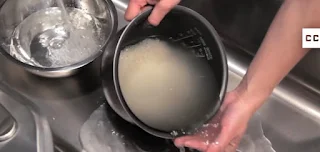Do you need to wash rice before cooking? Here’s the science
Rice is a staple rich carbohydrate food for billions of people who mostly prefer especially in Asia and Africa. It’s also a protean component for numerous iconic dishes from around the world, including dolmades from Greece, risottos from Italy, paella from Spain, rice puddings from the United Kingdom and Daal Bhaat from Nepal.
Despite its universal appeal, the question asked in every kitchen, be it a professional one or your own home, is whether you should pre-wash( or wash) or drain starch your rice before cuisine.
What do cookers and culinarans say?
Culinary experts claimpre-washing rice reduces the quantum of bounce coming from the rice grains. You can see this in the cloudy wash water, which studies have shown to be the free bounce( amylose) on the face of the rice grain produced by the milling process.
In culinary circles, washing is supported for some dishes when a promised grain is sought after. Yet for other dishes similar as risottos, paella and rice puddings( where you need a sticky, delicate effect), washing is avoided.
Other factors, similar as the type of rice, family tradition, original health warnings and indeed the perceived time and trouble needed will impact whether people pre-wash their rice.
For risotto, traditionally cooked with arborio rice, irrigating the rice isn't recommended, to help enhance the delicate texture of the dish.
Is there substantiation that washing rice makes it less sticky?
A recent study compared the effect of washing on the stickiness and hardness of three different types of rice from the same supplier. The three types were tenacious rice, medium grain rice and jasmine rice. These different rices were moreover not washed at each, washed three times with water, or washed ten times with clean water.
Contrary to what cookers will tell you, this study showed the washing process had no effect on the stickiness( or hardness) of the rice.
Rather, the experimenters demonstrated the stickiness wasn't due to the face bounce( amylose), but rather a different bounce called amylopectin that's percolated out of the rice grain during the cuisine process. The quantum percolated differed between the types of rice grains.
So, it’s the variety of rice – rather than washing – that’s critical to the stickiness. In this study, tenacious rice was the stickiest, while medium grain rice and jasmine rice were less sticky, and also harder as tested in the laboratory.
Hardness is representative of the textures associated with smelling and biting.
के तपाईंले भात पकाउनु अघि धुनु पर्छ? यहाँ विज्ञान छ
चामल अरबौं मानिसहरूका लागि मुख्य धनी कार्बोहाइड्रेट खाना हो जो प्रायः एशिया र अफ्रिकामा मनपर्छ। यो ग्रीसबाट डोल्माडेस, इटालीबाट रिसोटोस, स्पेनको पाएला, युनाइटेड किंगडमबाट चामलको पुडिंग र नेपालबाट दाल भात सहित विश्वभरका धेरै प्रतिष्ठित व्यंजनहरूको लागि प्रोटिन कम्पोनेन्ट हो।
यसको विश्वव्यापी अपीलको बावजुद, प्रत्येक भान्सामा सोधिएको प्रश्न, यो एक पेशेवर होस् वा तपाईंको आफ्नै घर होस्, तपाईंले खाना बनाउनु अघि आफ्नो चामललाई पूर्व-धौने (वा धुनु) वा निकास दिनुपर्छ।
कुकर र खाना पकाउनेहरू के भन्छन्?
पाक विज्ञहरू दावी गर्छन् कि चामल पहिले नै धुनुले चामलको दानाबाट आउने बाउन्सको मात्रा कम हुन्छ। तपाईंले यसलाई बादल धुने पानीमा देख्न सक्नुहुन्छ, जुन अध्ययनले मिलिङ प्रक्रियाबाट उत्पादित धानको दानाको अनुहारमा नि:शुल्क बाउन्स (एमाइलोज) भएको देखाएको छ।
पाक सर्कलहरूमा, प्रतिज्ञा गरिएको अन्नको खोजी गर्दा केही भाँडाहरू धुनेलाई समर्थन गरिन्छ। तैपनि रिसोट्टोस, पेला र चामल पुडिंगहरू जस्तै अन्य परिकारहरूका लागि (जहाँ तपाईंलाई टाँसिने, नाजुक प्रभाव चाहिन्छ), धुलाई बेवास्ता गरिन्छ।
अन्य कारकहरू, जस्तै चामलको प्रकार, पारिवारिक परम्परा, मौलिक स्वास्थ्य चेतावनीहरू र वास्तवमा आवश्यक समय र समस्याले मानिसहरूले आफ्नो चामल पूर्व-पौढाउने कि नगर्नेमा प्रभाव पार्छ।
रिसोट्टोका लागि, परम्परागत रूपमा आर्बोरियो चामलसँग पकाइन्छ, भातलाई सिंचाई गर्न सिफारिस गरिएको छैन, डिशको नाजुक बनावट बढाउन मद्दत गर्न।
के त्यहाँ चामल धोएर यसलाई कम टाँसिने बनाउँछ भन्ने प्रमाण छ?
भर्खरैको अध्ययनले एउटै आपूर्तिकर्ताबाट तीन फरक प्रकारका चामलको चिपचिपाहट र कठोरतामा धुने प्रभावलाई तुलना गरेको छ। ती तीन किसिमका धान थिए, मध्यम दानाको चामल र चमेली चामल । यी विभिन्न चामलहरू प्रत्येकमा नधोइएका, तीन पटक पानीले पखालिएका वा सफा पानीले दश पटक पखालिए।
कुकरहरूले तपाईंलाई बताउने कुराको विपरीत, यस अध्ययनले धुने प्रक्रियाले चामलको चिपचिपापन (वा कठोरता) मा कुनै असर नगरेको देखाएको छ।
बरु, प्रयोगकर्ताहरूले अनुहार बाउन्स (एमाइलोज) को कारणले चिपचिपापन होइन, बरु खाना प्रक्रियाको क्रममा चामलको दानाबाट बाहिर निस्कने amylopectin भनिने फरक उछाल भएको देखाए। क्वान्टम पर्कोलेटेड चामलको दानाका प्रकारहरू बीच फरक थियो।
त्यसोभए, यो चामलको विविधता हो - धुनुको सट्टा - यो चिपचिपापनको लागि महत्त्वपूर्ण छ। यस अध्ययनमा, कडा चामल सबैभन्दा चिपचिपा थियो, जबकि मध्यम दाना चामल र चमेली चामल कम टाँसिने थियो, र प्रयोगशालामा परीक्षण गरे अनुसार पनि कडा थियो।
कठोरता गन्ध र काट्ने संग सम्बन्धित बनावट को प्रतिनिधि हो।












